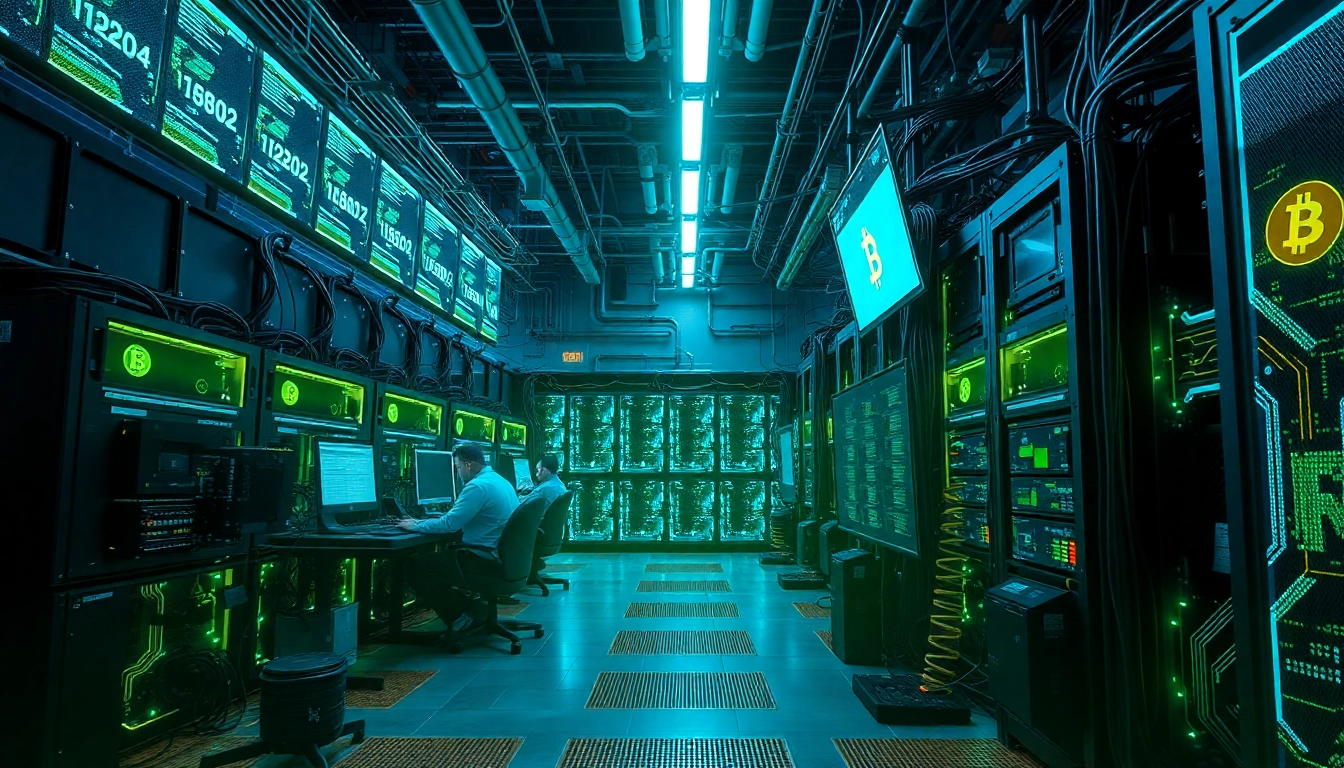Understanding Bitcoin Mining Basics
Bitcoin mining has emerged as a significant and fascinating aspect of the cryptocurrency universe. The process not only facilitates transaction verification within the Bitcoin network but also introduces new bitcoins into circulation. In essence, Bitcoin mining serves as the backbone of the Bitcoin economy, ensuring that transactions are processed accurately and efficiently. Let’s delve deeper into the fundamentals of this process, starting with its basic definition.
What is Bitcoin Mining?
Bitcoin mining is a decentralized and computationally intensive process utilized to secure transactions within the Bitcoin network. In simple terms, it involves solving complex mathematical problems, known as cryptographic puzzles. Miners, through their powerful computer systems, compete to solve these puzzles, and the first miner to successfully complete the task is rewarded with new bitcoins.
Upon solving a puzzle, a miner adds a new block to the blockchain—a public ledger of all past transactions. This block contains numerous transaction records, and its addition ensures the continuity and security of the entire network. The cryptography involved in this process provides the necessary security, allowing users worldwide to transact without the fear of manipulation
The Role of Miners in the Bitcoin Network
Miners play a vital role in the sustainability and functioning of the Bitcoin network. Their main responsibilities include:
- Transaction Verification: Miners confirm transactions by validating their authenticity, ensuring that no double-spending occurs. Once a transaction is verified, it’s included in a block.
- Network Security: By adding transactions to the blockchain, miners provide security against fraudulent activities and attacks, making it difficult for any malicious entity to alter past transaction data.
- Adding New Blocks: Miners who successfully solve cryptographic puzzles create new blocks on the blockchain, continuing the chain and maintaining its integrity.
Additionally, the competitive nature of mining ensures that miners remain motivated to maintain high performance levels, which in turn promotes network security.
Essential Equipment for Bitcoin Mining
The equipment used in Bitcoin mining is critical in determining the efficiency and profitability of operations. Here’s a rundown of essential mining equipment:
- ASIC Miners: Application-Specific Integrated Circuits (ASICs) are specialized hardware designed solely for the purpose of Bitcoin mining. They offer high computational power and energy efficiency compared to traditional CPUs and GPUs.
- Mining Rigs: A mining rig may consist of several machines connected to work together, significantly boosting computational power. These setups traditionally employ ASIC miners for optimal performance.
- Cooling Systems: The intense computational processes generate considerable heat, requiring efficient cooling systems to maintain optimal operating conditions and prevent hardware degradation over time.
- Power Supply Units (PSUs): High-quality PSUs are essential to provide the necessary voltage and current effectively to miners. They should be efficient to minimize energy costs, which are critical in the mining operations.
Investing in the right equipment can drastically improve mining productivity and reduce operational costs.
Types of Bitcoin Mining
There are various methods to engage in Bitcoin mining, each with its advantages and disadvantages. Understanding these can help you choose the best approach for your situation.
Solo Bitcoin Mining vs. Pool Mining
Two primary methods for mining Bitcoin are solo mining and pool mining:
Solo Mining: This method involves an individual miner attempting to solve cryptographic puzzles independently. While it offers the allure of receiving the full block reward, the chances of successfully mining a block are significantly low, especially for those with less computational power. The substantial computational difficulty increases the chances that many solo miners will never see a return on their investment.
Pool Mining: In pool mining, multiple miners combine their computational resources to increase their chances of solving puzzles and earning rewards. The rewards are then distributed among participants in proportion to their contributed processing power. This method allows for more stable and predictable income, making it a popular choice among newcomers and small-scale miners.
Bitcoin Cloud Mining Explained
Cloud mining offers another alternative, allowing individuals to rent mining power from remote data centers instead of purchasing and operating mining equipment. This method has several advantages:
- No Hardware Costs: Cloud mining services eliminate the need for upfront investment in expensive mining rigs and associated equipment.
- Reduced Maintenance: Users do not have to deal with hardware maintenance, repairs, or electricity costs, as these are handled by the cloud mining provider.
- Convenience: Cloud mining is accessible from anywhere, provided there’s an internet connection, making it user-friendly for those who lack technical expertise.
However, cloud mining comes with its own risks, including potential scams and less control over the mining process.
Choosing the Right Method for You
Selecting the appropriate mining method depends on various factors:
- Investment Size: Consider how much you are willing to invest in mining. Solo mining requires a more significant investment upfront, while pool mining and cloud mining can be more flexible.
- Technical Expertise: If you are experienced with hardware and software, solo mining might be rewarding. For novices, pool or cloud mining may be more suitable.
- Risk Tolerance: Solo mining involves more risk, as income can be uncertain. Pool and cloud mining provide more predictable but potentially smaller earnings.
Setting Up Your Bitcoin Mining Operation
Once you’ve decided on your mining method, it’s time to set up your mining operation.
Gathering Necessary Resources
Identify all necessary resources before launching your mining operation:
- Hardware: Acquire the right hardware based on your chosen method—ASIC miners for solo or pool mining, or select a reputable cloud mining service.
- Software: Install mining software tailored to your mining approach. Popular options include CGMiner, BFGMiner, and EasyMiner for local setups, while cloud services typically have their own software environment.
- Bitcoin Wallet: Set up a secure Bitcoin wallet to store mined bitcoins. Wallets come in various forms, including software, hardware, and online wallets. Choose one that meets your needs for security and accessibility.
Configuring Software and Hardware
Properly configuring your mining software and hardware is crucial to achieving optimal performance:
- Software Settings: Adjust the settings in your mining software to optimize performance based on your hardware capabilities and chosen mining minting pool.
- Pool Setup: If you are mining in a pool, ensure that you correctly configure your account details within the software.
- System Monitoring: Utilize monitoring software to keep track of system temperature, hash rates, and overall performance to preempt hardware failures.
Understanding Environmental Considerations
The energy consumption of mining operations raises important environmental concerns:
- Energy Sources: Evaluate the energy sources you plan to use. Renewable sources such as solar or wind can significantly reduce environmental impact and operational costs.
- Local Regulations: Be aware of local regulations regarding cryptocurrency mining and environmental impacts that could affect your operation.
- Efficient Cooling: Implement eco-friendly cooling solutions to minimize energy consumption while keeping equipment frosty, preventing overheating.
Maximizing Efficiency in Bitcoin Mining
Once your mining operation is set up, maximizing its efficiency is vital to profitability.
Optimizing Mining Hardware
Efficiently mining Bitcoin requires continual optimization of hardware:
- Upgrading Equipment: Regularly assess your current mining equipment’s performance and explore upgrading to newer, more efficient models as technology advances.
- Overclocking: If your hardware permits, consider overclocking it for increased output, but be aware of the risks, such as overheating and component degradation.
- Regular Maintenance: Routine cleaning and checking of mine equipment help ensure that all components function correctly and last longer.
Energy Consumption and Cost Management
Energy consumption can be one of the largest ongoing expenses in mining:
- Energy Providers: Negotiate competitive energy rates with local providers or choose locations with lower energy costs if you’re considering building a larger mining farm.
- Energy Efficiency: Use energy-efficient hardware and deploy strategies such as peak shaving to manage electricity needs effectively.
Monitoring Performance Metrics
Constantly monitoring the performance of your mining operation helps identify areas for improvement:
- Hash Rate: A higher hash rate typically indicates better performance in generating new bitcoins, so track this measure closely.
- Downtime: Minimize downtime due to hardware failure or network issues to keep operations running smoothly and efficiently.
- Profitability Calculators: Utilize tools that analyze potential profitability and risk factors based on your current setup and market conditions.
The Future of Bitcoin Mining
Looking ahead, various trends and challenges will shape the landscape of Bitcoin mining. Understanding these shifts can prepare miners for future changes and opportunities.
Emerging Trends in the Industry
The Bitcoin mining industry is rapidly evolving, with trends including:
- Green Mining: With growing environmental awareness and demands, the shift toward sustainable energy usage is more pronounced. Miners are exploring renewable energy sources to mitigate their carbon footprint.
- Hash Rate Shifts: Miners may face dramatic fluctuations in hash rate as more sophisticated miners enter the fray, requiring continuous adaptation to remain competitive.
Legal and Environmental Implications
With Bitcoin mining’s substantial energy consumption, regulatory scrutiny is increasing. Miners should stay informed about:
- Regulatory Changes: As various governments debate laws and guidelines relating to cryptocurrency and mining practices, staying abreast of these changes is crucial to circumvent legal issues.
- Environmental Policy: The adoption of stringent environmental policies may impact how and where mining operations can occur.
Preparing for Market Changes
Market volatility is an inherent characteristic of cryptocurrencies, and miners need to be resilient in the face of unpredictability:
- Diverse Strategies: Have a diversified mining and trading strategy to adapt to fluctuating bitcoin prices efficiently.
- Staying Informed: Monitor market trends, economic indicators, and technological advancements to prepare for anticipated changes within the mining sector.



